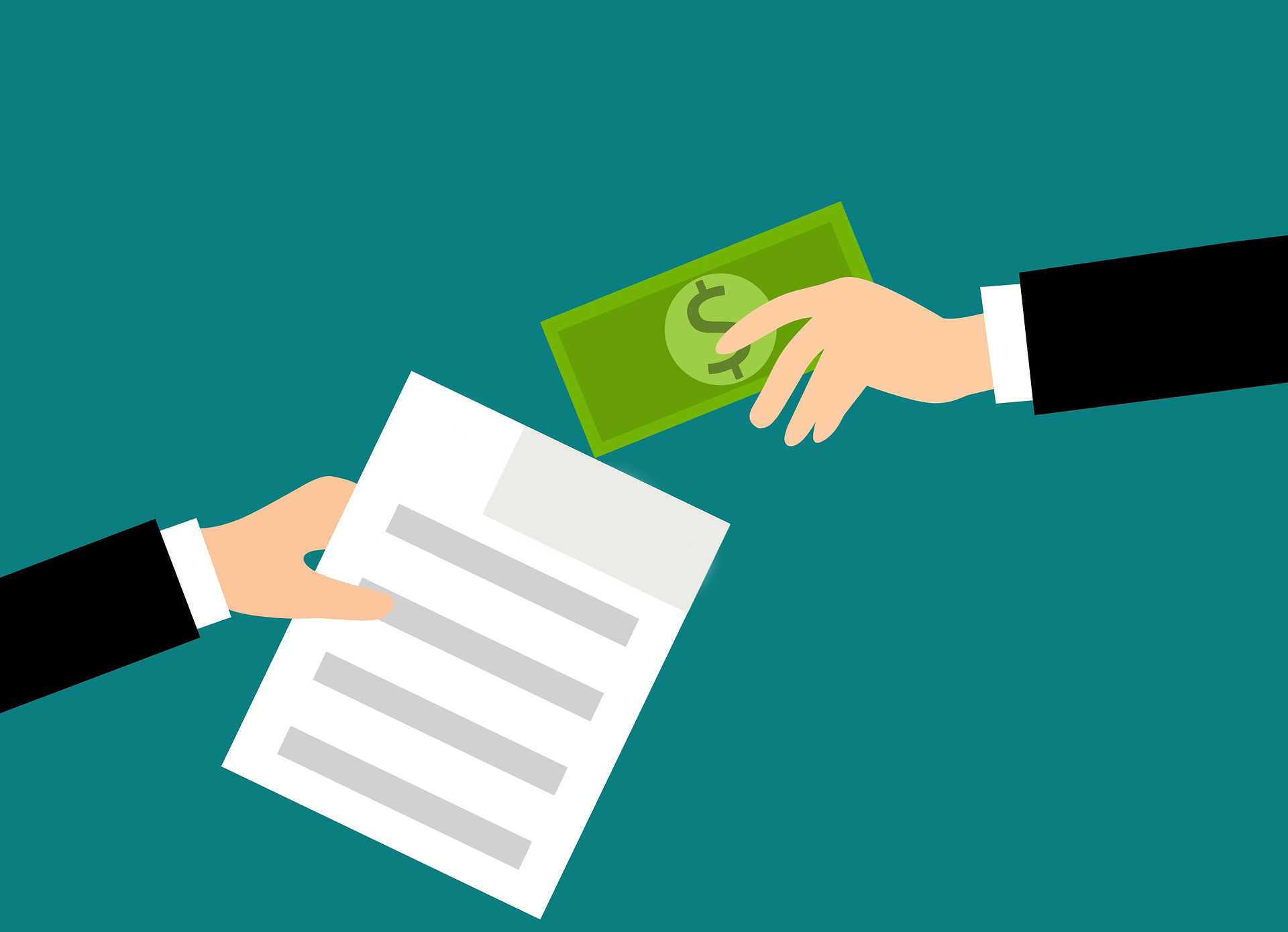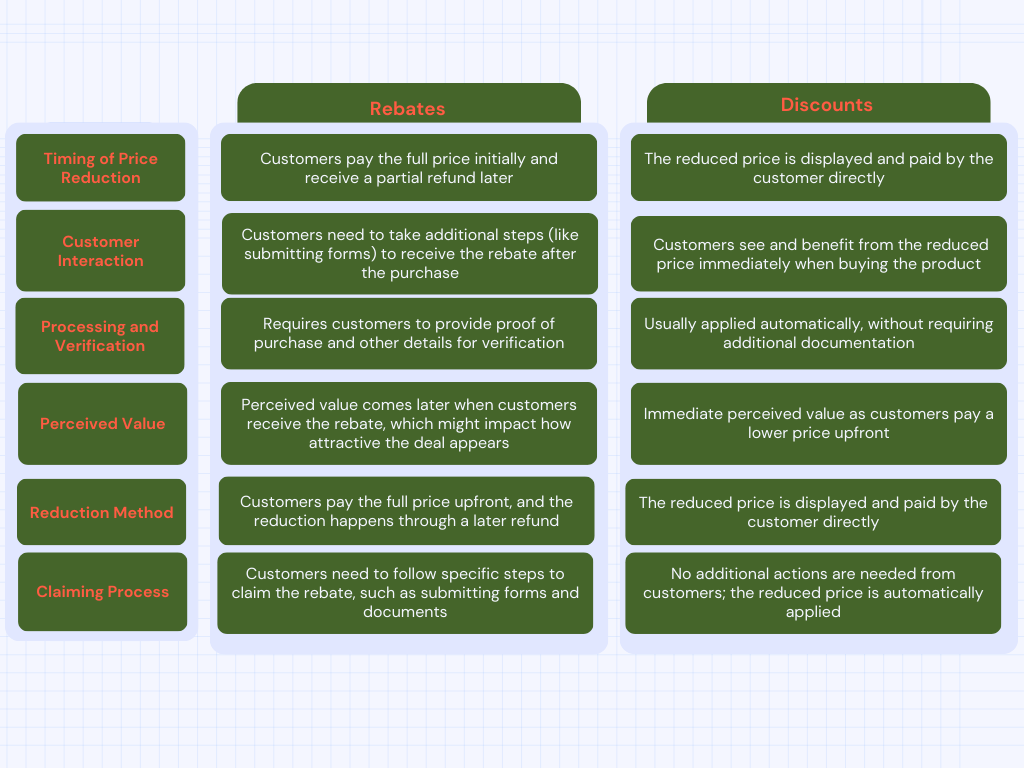What are Rebates?: Everything You Need to Know


by S. Losina
August 25, 2023
Rebates are a commonly used marketing tool that offers customers a partial refund on the purchase price of a product or service. They are a popular way for companies to incentivize customers to make a purchase, as well as to promote brand loyalty and increase sales. In this blog post, we will take a closer look at what rebates are, how they work, and why companies use them.
Whether you’re a business owner or a consumer, understanding rebates can help you make more informed decisions about your purchases and take advantage of potential savings. We would also look into how rebates differ from discounts. So, let’s dive in and explore everything you need to know about rebates.
Jump to section
What are Rebates?
- Rebates are a marketing tool used by companies to offer customers a partial refund on the purchase price of a product or service. When a customer purchases an item with a rebate, they can submit a claim to the company to receive a portion of the purchase price back. This can be in the form of a check, prepaid card, or credit towards future purchases. Instead of using the term ‘rebates,’ you’ll often come across expressions such as “cashback”.
- By offering a refund, companies give customers the opportunity to save money on their purchases, which can be a powerful motivator. Rebates can also help promote brand loyalty, as customers may be more likely to continue purchasing from a company that offers rebates.
- Rebates serve as incentives to motivate customers to make purchases, recent rebate statistics indicate that the implementation of product rebates by a company enhances the probability of consumer purchase completion by 75.4%.
Source: Incentiveinsights
How do Rebates Work?

- The process of obtaining a rebate typically involves a few steps. First, the customer purchases the product or service that is eligible for a rebate. This can be anything from electronics to household appliances to vehicles. The customer then fills out a rebate form, which usually requires providing proof of purchase, such as a receipt or invoice.
- Once the form is completed and submitted, the customer must send it to the company along with any required documentation. This can usually be done through mail, email, or an online submission form. The company will then review the claim and verify the eligibility of the purchase.
- If the claim is approved, the customer will receive their rebate in the agreed-upon form, such as a check, prepaid card, gift card, or credit towards future purchases. The amount of the rebate is typically a percentage of the purchase price, but it can also be a fixed amount.
Still a little confused ????, Here is a practical example:
Let’s say you really want to buy a new smartphone. You find out that a special phone you like is having a “rebate” deal. This means if you buy that phone, the company will give you $100 back later. So, you buy the phone at its regular price, let’s say it’s $500. After buying the phone, you would need to follow the instructions provided by the company to submit your rebate claim. This usually involves filling out a form, providing proof of purchase (such as a receipt or UPC code), and mailing it to the designated address.
Once your claim is received and approved by the company, they will issue you a rebate in the form of a check, prepaid card, or credit toward future purchases. This refund would typically be for the specified amount, in this case, $100. Now, you actually only paid $400 for the phone because of the rebate! It’s like a secret discount that makes your phone cheaper.
Types of Rebates
There are several different types of rebates that companies may offer to customers. Here are a few types:
- Mail-In Rebates: This is one of the most common types of rebates. Customers purchase the product or service and then mail in a rebate form along with proof of purchase to the company. After the company verifies the eligibility of the purchase, it will send the rebate to the customer.
- Instant Rebates: With this type of rebate, the discount is applied at the time of purchase. Customers do not need to go through the process of submitting a rebate form or waiting for a refund. This can be particularly enticing for customers as they see immediate savings.
- Online Rebates: Some companies offer online rebates where customers can submit their rebate claims electronically. This can be done through a company website or through a designated rebate submission portal. Online rebates offer convenience and faster processing times.
- Conditional Rebates: Conditional rebates are offered when certain conditions are met. For example, a customer may need to purchase a specific quantity or combination of products to be eligible for the rebate. This type of rebate encourages customers to make larger purchases or try new products.
- Loyalty Rebates: Loyalty rebates are offered to customers who have consistently made purchases from a company. These rebates may be in the form of discounts, credits, or exclusive offers. Loyalty rebates help to retain customers and encourage repeat business.
- Rebate Cards: Rebate cards are prepaid debit cards issued as part of a rebate offer. Customers receive these cards with a certain amount of money loaded onto them as a rebate, and they can be used for future purchases.
- Rebate Redemption Period: The rebate redemption period specifies the timeframe during which customers need to submit their rebate forms and fulfill any requirements to receive the rebate. It’s important to adhere to this period to avoid missing out on savings.
Between 40% and 60% of rebates are never redeemed
Edgar Dworsky, founder and editor of ConsumerWorld.org
Each type of rebate serves as a promotional strategy that businesses use to attract customers, increase sales, and encourage loyalty. Customers should always carefully read and follow the rebate instructions to ensure they receive the intended savings.
Why Do Companies Use Rebates?

Rebates have become a popular marketing tool for companies across various industries. They offer significant benefits that go beyond just increasing sales. Here are some four key benefits of rebates for companies;
- Increased Sales: The primary purpose of offering rebates is to boost sales. By providing customers with the opportunity to receive a partial refund after purchase, companies create a strong incentive for customers to make a purchase. This is particularly effective for higher-priced items, as the potential savings from a rebate can attract customers who may have been hesitant otherwise. Increased sales directly contribute to the company’s revenue and profitability. According to Statista, among the key factors impacting internet users in the United States when choosing where to shop online, rebates secured the third position in 2017.
- Brand Loyalty: Rebates help companies foster brand loyalty among customers. When customers have a positive experience with the rebate process, they are more likely to continue purchasing from the same company in the future. The sense of satisfaction from receiving a rebate reinforces their trust in the brand. This loyalty can lead to repeat business, long-term customer relationships, and positive word-of-mouth referrals.
- Market Research Opportunities: Rebate programs can provide valuable market research opportunities for companies. By collecting customer information during the rebate claim process, companies can gather insights into customer preferences, demographics, and purchase behaviors. This data can be analyzed to identify trends, improve product offerings, and target marketing campaigns more effectively. Market research obtained through rebate programs is a cost-effective way to gain valuable consumer insights.
- Competitive Advantage: Companies that offer rebates can gain a competitive advantage in the market. By providing customers with an additional incentive to choose their products, companies can differentiate themselves from competitors. This can be especially beneficial in saturated markets where customers have numerous options to choose from. Offering rebates can give companies a unique selling point and attract customers who are looking for the best deal.
Source: Statista
Discuss your incentives & rewards plan and goals with Huuray today.



Want to know more?
Key Considerations for Implementing Rebate Programs ????

Rebates can be a win-win situation for both the company and the customer. For the company, they provide a way to attract customers and incentivize them to make a purchase. For the customer, rebates offer a potential savings opportunity, allowing them to get a portion of their money back.
Implementing rebate programs requires careful planning and consideration to ensure their effectiveness and alignment with business goals. Here are key considerations to keep in mind:
- Clear Objectives
Define the purpose of the rebate program. Is it to increase sales, clear inventory, promote new products, or reward loyal customers? Clear objectives will guide your program’s structure. - Target Audience
Identify your target customers. Who are they? What are their preferences and purchasing behaviors? Tailor the rebate program to appeal to this audience. - Rebate Structure
Decide on the type of rebate that suits your goals, whether it’s mail-in rebates, instant discounts, tiered rebates, or others. Choose a structure that resonates with your target audience. - Rebate Amount
Determine the rebate amount carefully. It should be attractive enough to motivate action without hurting your profit margins. Analyze costs and potential ROI. - Terms and Conditions
Clearly outline the terms, conditions, and eligibility criteria for the rebate program. Be transparent about requirements, submission deadlines, and any limitations. - Validation Process
Establish a smooth process for customers to validate their rebate claims. This could involve the submission of receipts, proofs of purchase, or other required documentation. - Customer Experience
Design a user-friendly and streamlined process for customers to participate in the rebate program. Minimize barriers and make the redemption process as easy as possible. - Promotion and Awareness
Develop a comprehensive marketing strategy to promote the rebate program. Utilize various channels like social media, email marketing, and in-store displays to create awareness. - Budgeting
Allocate a budget for the rebate program that covers the costs of the rebates, administrative processes, and marketing efforts. Ensure it aligns with your business’s financial goals.
Rebates can be a valuable tool for companies to attract customers and incentivize purchases. However, implementing a successful rebate program requires careful planning, clear communication, and efficient processes. By considering these key factors, companies can create a rebate program that is effective, customer-friendly, and compliant with regulations.
At Huuray we offer over 5000 rewards and gifts that are used as incentive marketing to encourage and drive people to purchase a good or service. These incentives can take many different forms, including discounts, freebies, and samples, which are crucial components of any effective marketing strategy.
Difference between Rebates and Discounts
When it comes to shopping smarts and saving bucks, two terms frequently come into play: rebates and discounts. These money-saving heroes work in their own special ways, each with its own perks and things to think about. Let’s look at what sets rebates and discounts apart;

To sum up, rebates and discounts are both ways to reduce the cost of products or services, but they operate differently. Discounts offer an immediate reduction in the purchase price at the point of sale, making the item cheaper upfront. On the other hand, rebates provide a partial refund after the purchase is made, often requiring customers to submit a claim and fulfill specific requirements. While discounts provide instant savings, rebates offer potential savings after some effort and processing time.
The choice between the two depends on whether you prefer immediate cost reduction or are willing to go through a process for potential savings later.
Some benefits of Using Gift Cards as
Rebates

Gift cards have transcended their traditional role as presents, emerging as dynamic tools for businesses to engage customers and drive sales. When harnessed as rebates, these versatile cards offer a host of benefits that not only entice buyers but also provide a myriad of advantages for businesses. Let’s explore the many ways companies use gift cards as rebates, showing how this smart strategy benefits both shoppers and businesses. It’s a win-win situation for everyone!

- Versatility: Gift cards are a popular choice for rebates because they offer recipients the flexibility to choose what they want. Unlike traditional rebates that may only offer a specific product or service, gift cards allow customers to select from a variety of options based on their preferences.
- Increased Customer Engagement: By offering gift cards as rebates, companies can encourage customers to engage further with their brand. Customers are more likely to redeem a gift card, visit the store or website, and potentially make additional purchases. This can lead to increased customer loyalty and repeat business.
- Incentivize Spending: Using gift cards as rebates can incentivize customers to spend more than the value of the rebate. For example, if a customer receives a $50 gift card as a rebate, they may be more inclined to spend additional money to make the most of the gift card’s value. This can help drive sales and increase the average transaction value.
- Personalized Rewards: Gift cards can provide a personalized touch to the rebate experience. Companies can tailor the value of the gift card based on the customer’s purchase or spending behavior, making it feel like a personalized reward. This can enhance the customer’s perception of the rebate and create a positive brand experience.
- Easy Distribution: Gift cards can be easily distributed to customers as rebates. They can be delivered electronically via email or mobile apps, making it convenient for both the company and the customer.
Related:Gift Cards vs Cash: Which is the Better Gift Option?

Send yourself a gift card
Conclusion
To wrap up, in the world of shopping and smart saving, rebates hold a key to getting more value for your money. We’ve delved into how rebates work, from different types like mail-in and instant rebates to the journey of redeeming them and what sets rebates apart from discounts. Remember, the time it takes to get your rebate can vary, but the wait is worth it for that extra cash back. Rebates are like a special interest from companies and manufacturers to reward your purchase, making shopping an exciting adventure where both you and your businesses win. While discounts remain beneficial, it’s worth thinking about integrating a rebate program into your promotional strategies.
So, next time you shop, keep an eye out for those rebate opportunities – they’re your ticket to stretching your dollar further!



Let’s have a chat
FAQ
Rebates can be worth the effort depending on factors such as the rebate’s value, complexity of the process, and personal preferences. They offer cost savings and lower initial expenses, particularly for high-value items, but can involve a cumbersome process, potential for forgetfulness, and delayed savings. Deciding whether rebates are worthwhile involves calculating the value against the effort, considering the reliability of the offering party, and weighing the timeliness of the savings. Staying organized and assessing individual preferences are crucial in determining whether pursuing rebates aligns with one’s priorities.
The time it takes to receive a rebate varies based on the rebate program and the company processing it. Typically, after submitting all required documentation and completing the redemption process, it can take several weeks to a few months for the rebate to be processed and delivered. Factors such as verification procedures, the volume of submissions, and the method of payment (physical check, rebate card, or digital transfer) can influence the processing time. It’s advisable to refer to the specific terms of the rebate offer for an estimated timeline and to follow up with the company’s customer support if the expected time frame is exceeded.
To redeem a rebate, start by carefully reviewing the terms and conditions outlined in the rebate offer. Collect all required documentation, such as the original receipt and proof of purchase, and fill out any necessary rebate forms with accurate information. Submit your rebate documents through the specified method, whether online or by mail. Wait for processing and confirmation, and once your submission is approved, you’ll receive the rebate in the form of a check, rebate card, or digital payment. Make sure to adhere to any expiration dates or conditions associated with the rebate and follow up with customer support if needed.